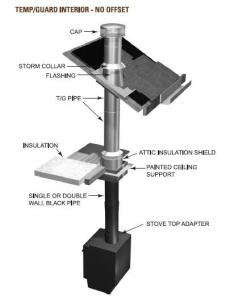With over 10 years of experience as a Certified WETT Inspector the Barrie Home Inspector offers Basic Site Inspection services for Wood Stoves, Pellet Stoves and Fireplaces.
Many people wrongly assume that they require a WETT Certificate to fulfill their insurance company requirements. Your WETT inspector is actually the one who is WETT Certified to perform the WET Inspection in accordance with Provincial Building Code requirements, Fire Code requirements and CSA requirements. Your trained WETT Certified Inspector will inspect your wood burning appliance and issue you with a report of the findings.
company requirements. Your WETT inspector is actually the one who is WETT Certified to perform the WET Inspection in accordance with Provincial Building Code requirements, Fire Code requirements and CSA requirements. Your trained WETT Certified Inspector will inspect your wood burning appliance and issue you with a report of the findings.
What is WETT?
Wood Energy Technology Transfer Inc. (WETT Inc.) is a non-profit training and education association managed by a volunteer Board of Directors elected by holders of valid WETT certificates. Through its administrative designate, WETT Inc. functions as the national registrar of the WETT program. Through professional training and public education, WETT Inc. promotes the safe and effective use of wood burning systems in Canada.
In carrying out its mandate to promote increased safety and effectiveness, WETT Inc. maintains the Wood Energy Technical Training program (WETT). The program is designed to:
- provide training to those who offer wood energy products and installation and maintenance services to the public and to those who conduct inspections of wood burning systems,
- confirm and recognize the knowledge and skills acquired through field experience, self-study and successful completion of WETT courses by issuing certificates of qualification,
- provide training to specialty audiences as the need and demand arises.
The WETT system consists of several courses recognizing the various types of work done by wood energy professionals. Certification is achieved by completing courses to earn educational credits. A technical reference manual has been prepared to assist trainees in preparing for courses and as a reference manual for certificate holders.
WETT trained professionals must abide by a code of ethics requiring professionalism in all aspects of their work. The installation and maintenance of wood burning appliances is not regulated in Canada. As a non-profit training and educational association, WETT does not oversee, nor is it responsible for, the workmanship of its members. As such, WETT does not act as a regulator. WETT does maintain internal processes to address breaches of our code of ethics, however WETT cannot become involved in resolving consumer disputes.
Objectives of WETT
- To develop, maintain, promote and deliver professional training courses within the framework of the Wood Energy Technical Training Program (WETT) for practitioners of trades related to the sale, installation, maintenance and inspection of systems using wood and other biomass fuels.
- To maintain a registry containing the names of holders of valid WETT certificates and those who are students under the program.
- To foster and promote among certificate holders the highest level of professional conduct in the delivery of services to the public.
- To encourage and promote the safe and efficient use of wood energy through the distribution of public information materials and through collaboration with government agencies and related industries.
- To foster and promote research and education in utilization of wood as a source of energy.
- To promote the interests and activities of the members of the organization in a reasonable and legal manner.
- To provide a forum for the discussion of issues of importance or interest to the members and to share information and opinions for the mutual benefit of the members.
- To carry on such other activities as may, from time to time, be ordered by the Board of Directors of the organization and which are consistent with these objectives
Woodburning Appliance Inspections: (WETT)
Do you require a basic visual inspection such as for insurance or pre-purchase inspection of a home equipped with a wood burning appliance or fireplace? A basic visual inspection is a general overview of the readily accessible parts to determine if the system meets current regulations. Most often homeowners ask about WETT (Wood Energy Technical Transfer) because their insurance company has asked that they have their appliance WETT certified
Typically, when people are looking for an insurance type of inspection, a visual inspection is conducted to determine if there is evidence of any problems with the installation. This includes examining clearances, chimney heights and visual signs of deterioration. If there are concerns identified, then the inspector should make a recommendation that the appliance be checked and, if necessary, repaired by a WETT certified technician
is conducted to determine if there is evidence of any problems with the installation. This includes examining clearances, chimney heights and visual signs of deterioration. If there are concerns identified, then the inspector should make a recommendation that the appliance be checked and, if necessary, repaired by a WETT certified technician
Woodstoves and fireplace inserts are required to be installed according to CSA B 365 Installation Code for Solid Fuel Burning Appliances and Equipment. Masonry fireplaces are required to be built to the Ontario Building Code. Most insurance companies, for home insurance purposes, require a report stating that the wood burning appliance meets these installation practices


Recent Comments